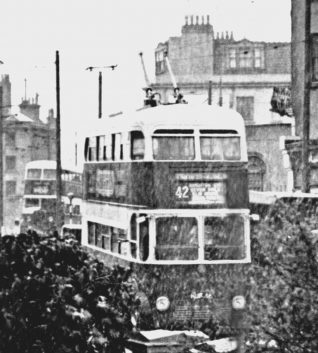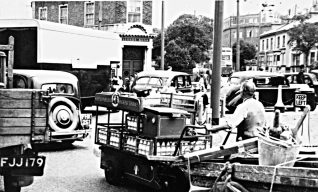Around the Seven Dials


From my birth in 1932 I lived with my parents in Chatham Place, one of the seven roads forming the hub of the Seven Dials, always a prominent Brighton landmark. Chatham Place was ideal for observing traffic in general and public transport in particular. My early years coincided with the eventual demise of the trams. When you look at the gradient today it’s hard to believe that these heavyweights could clatter up and down this hill in all weathers. ‘Leaves on the track’ or ‘the wrong sort of snow’ were not needed as excuses.
A long bamboo pole to the rescue
Indeed, virtually the only disruption came when the overhead pole came adrift from the wires that carried the power. Such happenings were quickly righted by the use of a long bamboo pole carried under each tram. A feature of these trams which particularly appealed to me was the way that the seat backs were pivoted so that the direction the passengers faced could be changed. These trams could also be driven from either end. Thus a tram going to Queen’s Park would ascend Elm Grove and pass over the points at the junction with Queen’s Park Road. Then the driver would change ends, the tram’s pole would be reversed, and the points adjusted. Then off it went towards the splendid ‘Pepper Pot’, the stop for the entrance to Queen’s Park.
Trams phased out
Just before the war the tram service was phased out and replaced by trolley buses. The first sign of change was the siting of new poles to hold the all important wires. The trolley buses would take on power overhead as did the trams, but would not be restricted by having to run on rails. I well remember the fitting of the overhead wires at night. Tip-toeing to an upstairs window in my pyjamas I could watch the huge rolls of gleaming copper wire being attached to the overhead system.
New fangled trolley buses
When the trolley buses made their appearance it was immediately evident that they were as quiet as the trams had been noisy. I remember being on a walk with my father, and as we came past Preston Circus a blind man was standing on the kerb seeming rather unsure. As we helped him across the road he explained that whereas he could pick out the trams by their noise, the quietness of the new-fangled trolley buses presented a hazard for him. Trolley buses were of course a hybrid, half bus and half tram. There was still the problem of the trolley poles losing contact but they didn’t have the restriction caused by running on rails. Of course they were much more comfortable for the passengers, but they lacked the raw mechanical appeal for this young lad! Later I was to become interested in photography and took this photo from the sitting room window. It shows a No. 42 trolley bus on its way down Chatham Place in a snow flurry.
My first car
Another later memory is that when I got my first car in 1954 I was able to park outside the house in the narrow road without causing any ‘road rage’ as far as I am aware. At least the trolley bus. had much increased manoeuvrability. All of which brings me to the other photo, my first ever to be published in a newspaper. It shows what in those days was considered a traffic jam! Interestingly two of the vehicles in the foreground are hand propelled – an anonymous painter decorator’s handcart and a Holes & Davigdor ‘Hygienic Dairies’ milk float. Another 42 trolley bus can be seen in the distance approaching the ‘gridlock’!
Now the trolley buses too are gone, but traffic jams will be with us for a long time yet…




Comments about this page
Hi, not wishing to be a smart alec, but I believe the background bus is likely to be an AEC of the Corparation Fleet.
Great information – very informative. I needed to know the difference between trams and trolly buses. Thanks.
It was the trolleybuses that carried a long bamboo pole in a tube underneath the vehicle, used to raise or lower the ‘sticks’ . For the same purpose, the trams had a rope attached to the head end of the trolley pole. It is visible in many photos. The trolleybus in the top picture is one of the first postwar batch of vehicles delivered to Brighton Corporation, new in 1948.
The trolleybus in the top photo apears to be Corporation No. 46 (HUF 46), one of four which were sold in 1959 to Bournemouth Corporation when the first trolleybus to bus conversions took place in Brighton. It lasted in Bournemouth, as their No 289 until 31/07/65.
The number 42 bus, whatever a trolly or standard petrol was a circular route around Brighton for many years.I am able to confirm that the driver of both as a trolly bus and any other, was a guy called, Edward Wise, for many years, an uncle of mine. I have lived in York for a number of years now, and one day we passed a model shop, in the window was a model of the trolly bus that Ted Wise drove for many years. The registered number was H U F 42. shown in a photo on this site, you can just make out the number on the photo.
Add a comment about this page